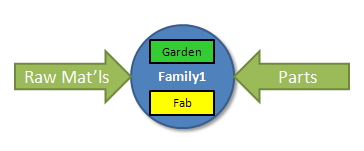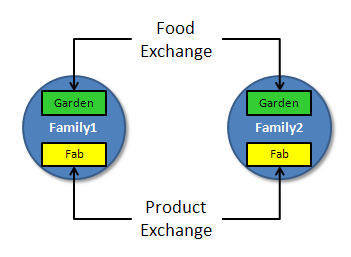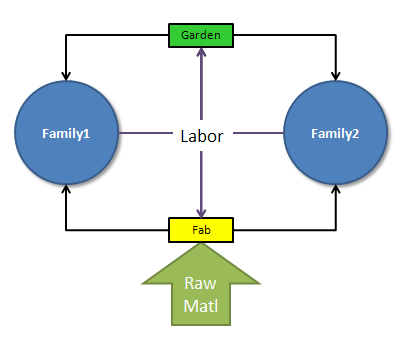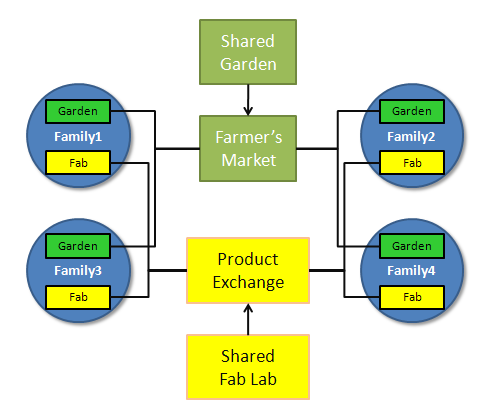OSEC Models of Cooperation
Basics
- Models of community cooperation vary somewhat by scale. Several models of cooperation are presented and analyzed here.
- This page mainly goes over the analysis of Community Scale
Individual Self-Sufficiency
Even if a person or family unit is in complete agreement with OSE principles, local factors may force them into making a go of it themselves. As such, the model is one of self-sufficiency leveraging the GVCS were possible.
A garden is developed with food self-sufficiency in mind. This may include animal production as well. In order to have a sustainable food production capability, the family will need to:
- compost vegetable, scraps, and manure.
- save seeds and propagate plants
- breed animal to propagate them
- plant perennial food crops (fruit and nut trees, vines, etc.)
- preserve food for winter and lean months
With self-sufficiency as a goal, the family will need to acquire a comprehensive set of tools to maintain their lifestyle. Ideally, these tools will include the fabrication tools included in the GVCS. Even given a good set of tools, the family will likely need to purchase external parts and products, thus creating a need for money (at least at this stage of civilization). This creates a whole set of secondary problems, many of them counter to self-sufficiency.
Model Benefits
- Lots of freedom
- Reduced cost of living
- Locally sustainable, to some degree
Negative Aspects
- More risk, no help if something goes wrong
- Need money to buy parts, products, and material
- True self-sufficiency is difficult to attain
- Labor requirements are large
Neighbors
In the neighbors model, two families that share OSE principles live close to each other, ideally adjacent. While the two families are independent of each other, they share and swap food and fabricated products. A certain amount of specialization arises as one family is better at producing something, and the other something else.
This model shares many of the aspects of the self-sufficiency model, but reduces risk and potentially reduces labor requirements. Furthermore, the waste stream of one might be utilized by the other.
Model Benefits
- Reduced risk
- Social interactions
- Further reductions in the cost of living
- Increase pool of knowledge and skill
- Allows for a small degree of specialization
- Minimal distance for sharing and exchange
Negative Aspects
- A bit less freedom and privacy
- No communal property, tools are not shared
- Requires close cooperation, understanding, and communication
Communal Living
As we scale up the number of participants, other models start to emerge. One of them is the communal living model in which food production and product fabrication become a communal effort. Land and tools are generally held in common. Participants contribute labor and share in the results.
This model was played out in many variations in the 1960's and 1970's. Some of those efforts are still around, but very, very few. Perhaps most of them failed due to the inability to coordinate action between the participants. Some may have failed for ideological reasons, but we should assume that most or all participants are in agreement with the basic principles, else why join (assuming participation was voluntary).
Model Benefits
- Land and food production benefit all
- Fabrication can be very efficient by division of labor
- Shared housing and shelter scale well
- Initial pooling of resources help to get things started
- All share in the benefits equally
- Greatly reduces risk due to natural disasters, etc.
- Reduced consumption (?)
Negative Aspects
- Actions of individuals can be difficult to coordinate
- Group politics, in fighting, etc. further break down coordination of action
- Inequitable contributions of labor lead to resentment
- If food and resources are not share equally, that also causes problems
- Hierarchical organization can eliminate some problems, but causes others
- Achieving consensus on priorities can be difficult
- Adding and subtracting participants is disruptive
- Maintaining motivation and commitment among participants can be difficult
Factor e Farm is run as a hierarchically organized commune. Visiting participants live communally and contribute their labor in return for knowledge and skill. They work under the direction of supervisors and the ultimate leadership of Marcin.
Village Market
The village market model combines some aspects of communal living and neighbors. Participants are semi-autonomous and have their own gardens and tools. Some land is communally shared and worked. Special fabrication tools (especially the heavy duty ones and less often used ones) are also shared communally. Also shared are two forms of centralized exchange: a farmer's market and a product exchange. Families contribute excess food to the farmer's market and may take away food products that they do not produce themselves. The product exchange serves the same purpose for hard goods. Both resource-based and monetary-based economic models can be applied to these exchanges.
Model Benefits
- Many of the advantages of both the neighbor and communal living models
- Fosters the idea of individuality while retaining shared goals
- Personal choice is allowed in family garden plots while keeping the efficiencies of shared plots
- Easy things are made in the home, harder things on special, shared equipment
- Some food preservation can be centralized in the farmer's market (larger freezers, etc.)
- Inventory of materials can be centralized in the shared fabrication lab
- Waste streams can be re-used centrally
- Resource conversion (aluminum extraction from clay for example) can be done centrally
- Abundance is shared
- Could be a closed system if sufficient resources are present
- Exchanges can sell to the outside if money is needed
Negative Aspects
- Shares the coordination of action problems of the communal living model
- Ownership can become complex since somethings are owned by families and other things are shared
- If values are not truly shared, sharing food, labor, and products will be impacted
- Adding and subtracting participants is even more difficult, since ownership of property is involved
Some existing eco-villages are organized along the lines of this model. The | Ithaca Eco-village, for example, allows condo or house ownership (or renting) while encouraging community participation. A shared CSA-style garden is worked by members. Workshops, training, etc. is offered by the village, which is run by consensus. The Ithaca village has been running for a bit over 20 years and has three "neighborhoods".
Internal Links
- Scale (Analytics)
- A Much More Disconnected/Far Out, Large, Macro Scale Analysis:



